Athena Review Vol. 5, no. 1
Records of Life: Fossils as Original Sources
41. Modern Apes: Africa and Asia
Hominoidea

The hominoid family includes humans (Homo sapiens, and all fossil ancestors, called hominins), and the four great apes, including chimpanzees, gorillas, orangutans, and gibbons. Genetic and protein studies have shown the relative similarities of these taxa (fig.1).
Fig.1: Relationships among apes, based on protein electrophoresis data showng relative branch lengths (after Goldman et al. 1987) .
Chimpanzees
Pan troglodytes, the chimpanzee (family Hominidae), has four subspecies now living in western and central Africa.The English word "chimpanzee" is derived from the Tshiluba language chimpenze, meaning "ape".
 The chimpanzee is more robustly built than the bonobo, but less so than the gorilla. Adult chimpanzees have an average height of 150 cm. Males weigh between 40–70 kg and females weigh 27–50 kg. The
arms of a chimp are longer than its legs, and can reach below the
knees, The hands have long fingers with short thumbs and flat
fingernails. The feet are adapted for grasping, the big toe being
opposable (fig.2).
The chimpanzee is more robustly built than the bonobo, but less so than the gorilla. Adult chimpanzees have an average height of 150 cm. Males weigh between 40–70 kg and females weigh 27–50 kg. The
arms of a chimp are longer than its legs, and can reach below the
knees, The hands have long fingers with short thumbs and flat
fingernails. The feet are adapted for grasping, the big toe being
opposable (fig.2). A chimp's head is rounded with a prominent and prognathous face and a pronounced brow ridge. It has a small nose and large, rounded non-lobed ears. Adult males have sharp canine teeth. Chimps lack the prominent sagittal crest and associated head and neck musculature of gorillas (Estes 1992)
Chimpanzees live in groups of between 20 to over 150 members, but spend most of their time travelling in small, temporary groups consisting of a few individuals (Goodall 1968). The chimpanzee is an omnivore. It eats mainly fruit, but also can eat leaves , seeds, blossoms, stems, and bark, along with honey, soil, insects, birds and their eggs, and small to medium-sized mammals, including other primates.
Fig.2: Young chimpanzee from the Central African Republic (photo: Wikipedia)
Chimpanzees have been described as highly territorial and will kill other chimps. At Gombe, Jane Goodall (1986) described groups of male chimps patrolling the borders of their territory, brutally attacking chimps which had split off from the Gombe group. Patrol parties from large groups even take over a smaller group's territory, gaining access to more resources, food, and females. While formerly believd that only female chimpanzees immigrate and males remain in their natal troop for life, there are cases among West African chimpanzees of adult males safely integrating themselves into new groups (Sugiyama and Koman 1979).
Bonobo chimpanzees
The bonobo chimpanzee (Pan Paniscus), also called the pygmy chimpanzee, is one of two species making up the genus Pan, along with the common chimpanzee (Pan troglodytes). The bonobo lives in a 500,000 km2 (190,000 sq mi) area of the Congo Basin in the Democratic Republic of the Congo, Central Africa. Bonobos are found only south of the Congo River and north of the Kasai River (a tributary of the Congo).
The species inhabits primary and secondary forests, including seasonally inundated swamp forests. The bonobo is an omnivorous frugivore, most of its diet being fruit supplemented with leaves, honey, eggs, and meat from small vertebrates. The bonobo, slightly smaller than the common chimp, has relatively long legs. Bonobos typically live 40 years in captivity. Their lifespan in the wild is unknown, but it is probably shorter.
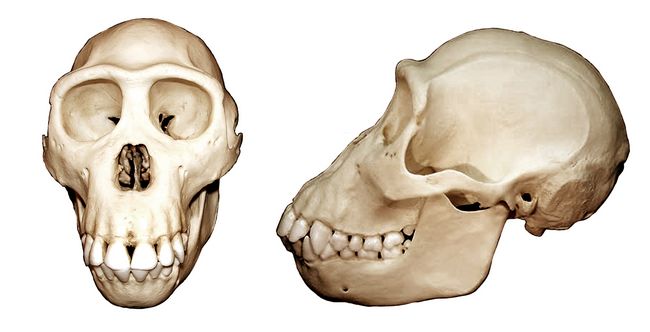 bonobo
was first recognised as a distinct taxon by German anatomist Ernst
Schwarz (1929), who classified the bonobo as a subspecies of chimp. A
few years later, American anatomist Harold Coolidge (1933) elevated it
to species status. American psychologist and primatologist Robert
Yerkes was one of the first to notice major behavioural differences
between the bonobo and the common chimp.
bonobo
was first recognised as a distinct taxon by German anatomist Ernst
Schwarz (1929), who classified the bonobo as a subspecies of chimp. A
few years later, American anatomist Harold Coolidge (1933) elevated it
to species status. American psychologist and primatologist Robert
Yerkes was one of the first to notice major behavioural differences
between the bonobo and the common chimp.Fig.3: Skull of a female Bonobo chimpanzee (Pan paniscus)
The bonobo genome was published in June 2012, based on a female bonobo from the Leipzig zoo. This confirmed that the bonobo genome is about 0.4% divergent from the chimpanzee genome. DNA evidence suggests the two species diverged about 890,000–860,000 years ago, due to physical separation of these two populations (Caswell et al 2008). The first fossils of Panwere reported in 2005 from the Middle Pleistocene (after the bonobo–chimp split) of Kenya, alongside early Homo fossils (McBrearty and Jablonski 2005).
Currently, these two species are separated by the Congo River. As the two species are not proficient swimmers, the formation of the Congo River in the early Pleistocene period 1.5–2.0 mya possibly led to their separation into two species. Bonobos live south of the river, and were presumably separated from the ancestors of the common chimpanzee who lived north of the river.
Based on genetics, along with the common chimpanzee, the bonobo is the closest extant relative to humans. DNA comparison suggests continual interbreeding between ancestral Pan and Homo groups, post-divergence, until about 4 million years ago. According to Zihlman et al (1978), bonobo body proportions closely resemble those of Australopithecus.
While common chimpanzee males are hostile to males from outside the community, attacking any single male outsiders and sometimes killing them, this does not appear to be the behavior of bonobo males or females. According to some anthropologists, human ancestors went through a bonobo-like phase featuring reduced aggression and associated anatomical changes, exemplified in Ardipithecus ramidus (Clark and Hennebert 2015).
Gorillas
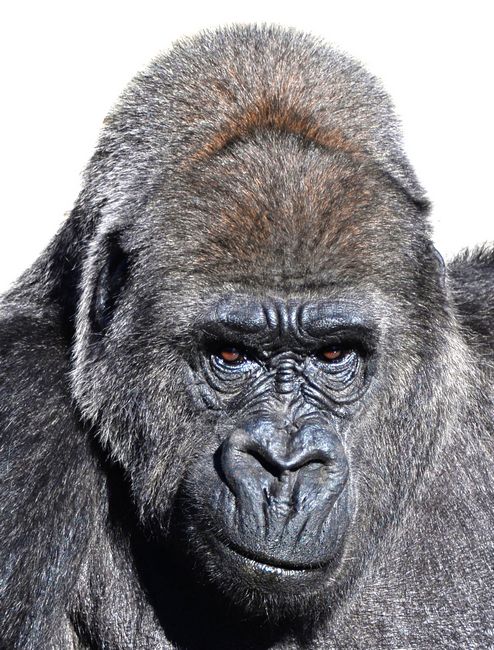 The genus Gorilla is divided into two species: the eastern gorilla (Gorilla berengei) and the western gorilla (G. gorilla),
with four subspecies, all living in Central Africa. The range of
the two species is separated by the Congo River and its tributaries.
Speciation may have occured from a single type of gorilla during the
Pleistocene Ice Age, when their forest habitats shrank and became
isolated from each other. Gorillas, the largest living primates, have
DNA very similar to that of both chimpanzees and humans, from 95 to 98%
.
The genus Gorilla is divided into two species: the eastern gorilla (Gorilla berengei) and the western gorilla (G. gorilla),
with four subspecies, all living in Central Africa. The range of
the two species is separated by the Congo River and its tributaries.
Speciation may have occured from a single type of gorilla during the
Pleistocene Ice Age, when their forest habitats shrank and became
isolated from each other. Gorillas, the largest living primates, have
DNA very similar to that of both chimpanzees and humans, from 95 to 98%
.The name Gorillai in ancient Greek meant "tribe of hairy women." This is derived from the expidition of Hanno the Navigator, who in ca. 500 BC visited Sierra Leone and encountered "hairy women ... whom our interpreters called Gorillae."
Fig.4: Gorilla gorilla, the Western Lowlands Gorilla.
Western lowland gorillas (Gorilla gorilla) are ground-dwelling, mainly herbivorous hominoid apes that live in Central West African countries in dense forests and lowland swamps and marshes as low as sea level.
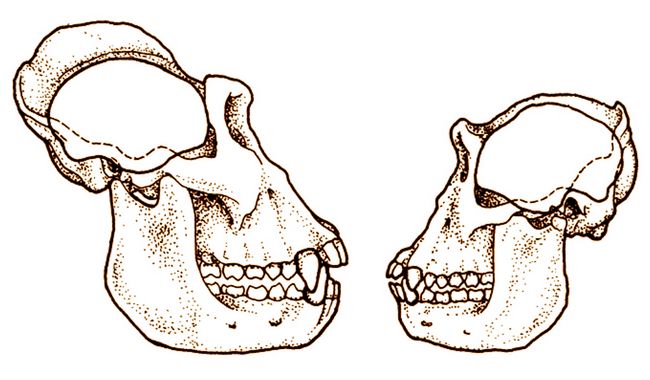
Gorilla facial structure is prognathic, with the mandible (lower jaw) protruding farther out than the maxilla (upper jaw). There is significant sexual dimorphism (fig.5). Adult males have a prominent sagittal crest, and both males and females have a bunlike bone projection in the rear of the skull, for muscle attachments.
Fig.5: Sexual dimorphism in the modern gorilla. Left: male skull (cranial cavity 550 cc); right: female skull (440 cc). Note size differences in canines and other teeth, and the sagittal crest on top of the skull for jaw muscle attachments (after Zihlman 1982)
Orangutans
Orangutans (Pongo pygmaeus) are great apes (family Hominoidea) who live in southeast Asia. Orangutans are divided into two subspecies, one inhabiting Borneo and the other in Sumatra. The name "orang-outang" is the local Malay name for this ape, recorded in Java the the 17th century by the Dutch physician Jacobus Bontius.
Unlike the African great apes, the ancestral fossil lineage of the Orangutan is relatively well known, being traced back to Sivapithecus, a Miocene hominoid from Pakistan dated between 13-8 mya. Sivapithecus and Pongo share several derived cranial features including a high degree of prognathism, oval orbits, a narrow nasal aperture, and broad zygomatic arches. In these features, and in their high, rounded braincase, the skulls of Orangutans differ from that of the African great apes (Fleagle 1999).
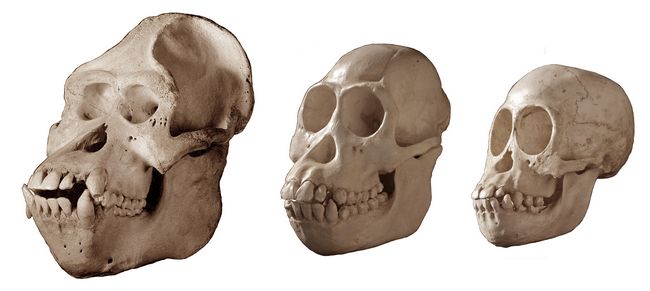 While there is considerable sexual dimorphism in hominoid species, this is especially true of Pongo.
Males, weighing about 120 kg, are about twice as large as females. The
adult male Pongo (orangutan) has a robust skull and jaw with massive
teeth (fig.6). The huge jaw muscles are attached to a ridge at the top
of the skull called a sagital crest, found in male
hominoids, past and present, but less prominently, or not at all, in females.
While there is considerable sexual dimorphism in hominoid species, this is especially true of Pongo.
Males, weighing about 120 kg, are about twice as large as females. The
adult male Pongo (orangutan) has a robust skull and jaw with massive
teeth (fig.6). The huge jaw muscles are attached to a ridge at the top
of the skull called a sagital crest, found in male
hominoids, past and present, but less prominently, or not at all, in females.Fig.6: Skulls of Orangutans, including an adult male (left), female (center) and juvenile (right).
Male orangutans are also unique in having two periods of maturation. The first occurs between the ages of eight and fifteen, when males are known as subadult and have the ability to reproduce, although they have not reached full maturity. Fully adult males are larger than subadult males and also have distinct cheek pouches.
Orangutans subsist mostly off fruit and leaves, although males add termites to their diet when terrestrial. Orangutans have a social structure similar to that of nocturnal prosimian primates. Most individuals are solitary and have separate home ranges. Females have relatively small home ranges and are typically accompanied by their offspring. Males have larger home ranges that overlap those of several females.
Gibbons
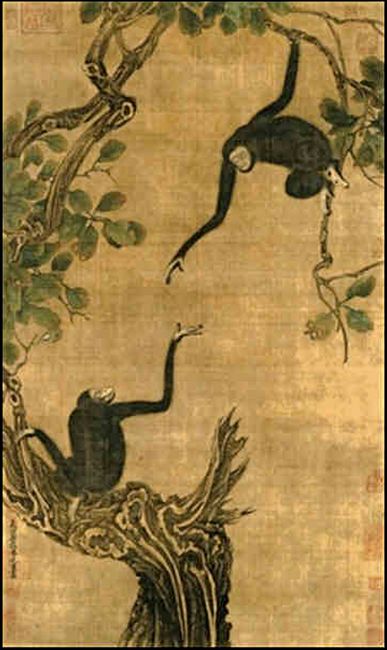 Gibbons are apes in the family Hylobatidae, originally comprising one genus (Hylobates),
but now split into four genera and 18 species. Gibbons live in
subtropical and tropical rainforest, over a large area from eastern
Bangladesh, Northeast India, and southern China to Indonesia, including
the islands of Sumatra, Borneo, and Java. Gibbons
are smaller than the other hominoid apes (chimpanzees, gorillas, and
orangutans) and in some respects resemble monkeys. They are the fastest
and most agile of all tree-dwelling mammals.
Gibbons are apes in the family Hylobatidae, originally comprising one genus (Hylobates),
but now split into four genera and 18 species. Gibbons live in
subtropical and tropical rainforest, over a large area from eastern
Bangladesh, Northeast India, and southern China to Indonesia, including
the islands of Sumatra, Borneo, and Java. Gibbons
are smaller than the other hominoid apes (chimpanzees, gorillas, and
orangutans) and in some respects resemble monkeys. They are the fastest
and most agile of all tree-dwelling mammals.Gibbon species include the siamang, the white-handed or lar gibbon, and the hoolock gibbons. The genus Hylobates ("forest walker") was once considered the only genus of gibbons, but recently its subgenera (Hoolock, Nomascus, and Symphalangus) have been elevated to the genus level, within the family Hylobatidae. Hylobates remains the most widespread of the gibbon genera, ranging from southern China (Yunnan) to western and central Java. The Hoolock gibbons include three species native to eastern Bangladesh, Northeast India, Myanmar and Southwest China (fig.7).
Fig.7: Painting of two gibbons in an oak tree, by the Song dynasty painter Yì Yuánjí (ca 1000-ca 1064), representing gibbons living in China.
Genetics show that gibbons were the first apes to diverge from the common ancestor of humans and apes about 16.8 million years ago. The gibbon genome has a 96 percent similarity to humans, making it a bridge between that of Old World Monkeys and the great apes. The four gibbon genera diverged from each other about 5-7 Mya.
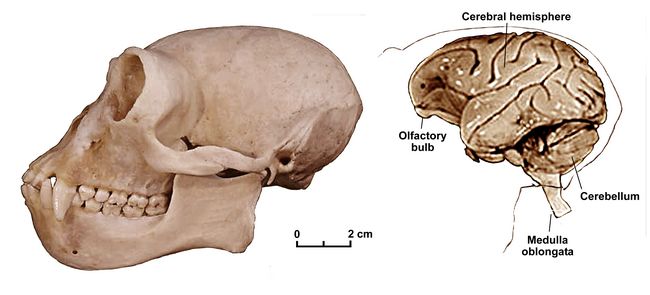 The gibbon's wrist is
unique, working like a ball and socket joint, allowing for biaxial
movement. Gibbons have long hands and feet. Their skulls and teeth
resemble those of the great apes, with a dental formula of 2.1.2.3.
Their noses are similar to those of all catarrhine (Old World)
primates.
The gibbon's wrist is
unique, working like a ball and socket joint, allowing for biaxial
movement. Gibbons have long hands and feet. Their skulls and teeth
resemble those of the great apes, with a dental formula of 2.1.2.3.
Their noses are similar to those of all catarrhine (Old World)
primates. Fig.8: Skull and brain of the female Hoolock gibbon (Los Angeles Mus Nat.Hist.; Brain Encyclopedia)
Gibbons eat about 60% fruit, supplemented by twigs, leaves, insects, flowers, and bird eggs. Gibbons are strongly territorial, and defend their boundaries with vigorous visual and vocal displays. The latter consist of a duet between a mated pair, with their young sometimes joining in. Gibbons often retain the same mate for life.
References:
Carbone, Lucia; et al. 2014. Gibbon genome and the fast karyotype evolution of small apes. Nature. 513: 195–201.
Caswell J.L., S. Mallick , D.J. Richter 2008. In McVean, Gl (ed.). Analysis of Chimpanzee History Based on Genome Sequence Alignments. PLOS Genet. 4 (4)
Clark, G. and M. Henneberg 2015. The life history of Ardipithecus ramidus: A heterochronic model of sexual and social maturation. Anthropological Review. 78 (2): 109–132.
Coolidge, H.J. 1933. Pan paniscus. Pigmy chimpanzee from south of the Congo river. American Journal of Physical Anthropology. 18 (1): 1–59.
Estes, R. 1991 . The behavior guide to African mammals: including hoofed mammals, carnivores, primates. University of California Press. pp. 545–557
Fleagle 1999.:
Geissmann, T 1995. Gibbon systematics and species identification. International Zoo News. 42: 467–50
Goldman, D., P.R. Giri, and S.J. O'Brien 1987. A molecular phylogeny of the hominoid primates as indicated by two-dimensional protein electrophoresis. Proceedings of the National Academy of Sciences 84 (10): 3307–331
Goodall, J. 1986
Goodall, J 1968. The Behaviour of Free-Living Chimpanzees in the Gombe Stream Reserve . Animal Behaviour Monographs (Rutgers University). 1 (3)
Groves, C. 2002 . A history of gorilla taxonomy. In A.B.Taylor & M.L.. Goldsmith (eds.). Gorilla Biology: A Multidisciplinary Perspective. Cambridge University Press. pp. 15–34.
Hair, P. E. H. 1987. The Periplus of Hanno in the History and Historiography of Black Africa. History in Africa. 14: 43–66.
McBrearty, S. and N.G. Jablonski, 2005. First fossil chimpanzee. Nature. 437 (7055): 105–8.
Montagu, M. F. Ashley 1940. Knowledge of the Ape in Antiquity. Isis. 32 (1): 87–102.
Schwarz, E. 1929. Das Vorkommen des Schimpansen auf den linken Kongo-Ufer. Revue de Zoologie et de Botanique Africaines. 16: 425–426.
Sugiyama, Y. and J. Koman, Jeremy 1979. Social structure and dynamics of wild chimpanzees at Bossou, Guinea. Primates. 20 (3): 323–339 .
Zihlman, A.L, J.E. Cronin, D.L. Cramer,and V.M. Sarich, 1978. Pygmy chimpanzee as a possible prototype for the common ancestor of humans, chimpanzees and gorillas. Nature. 275 (5682): 744–6. :
Zihlman, A.L. 1982. The Primate Coloring Book.
Glossary